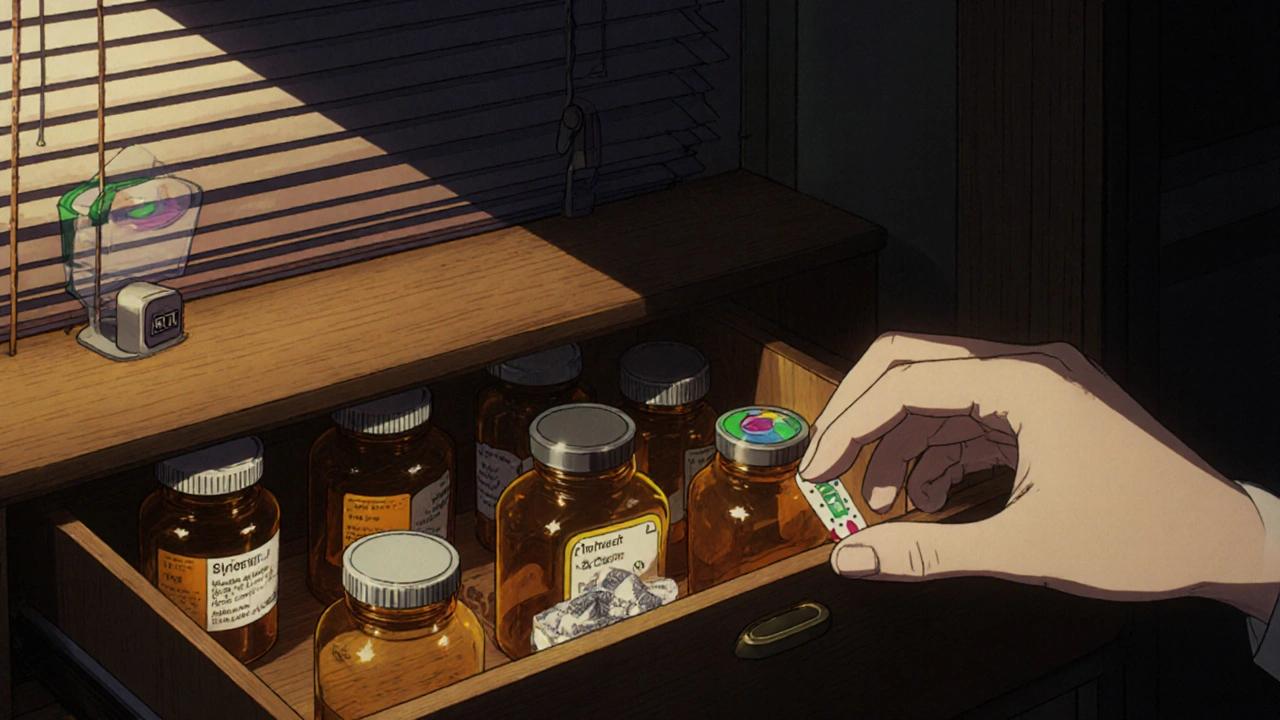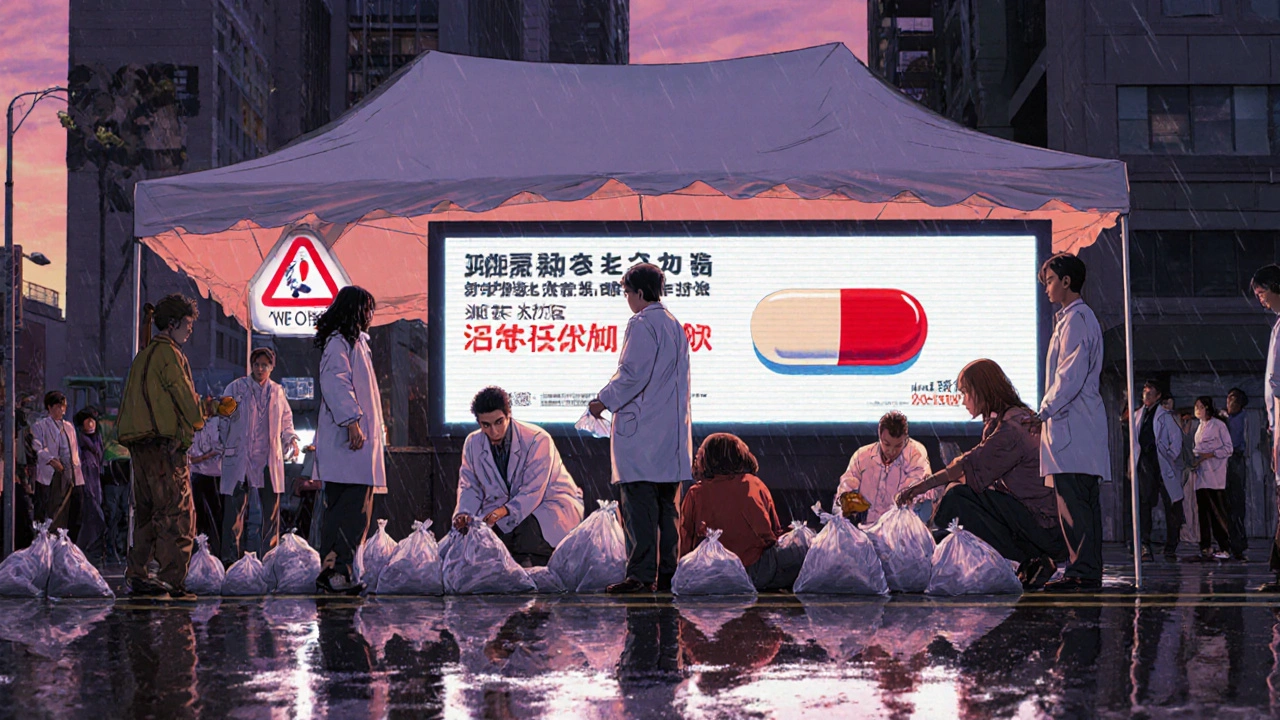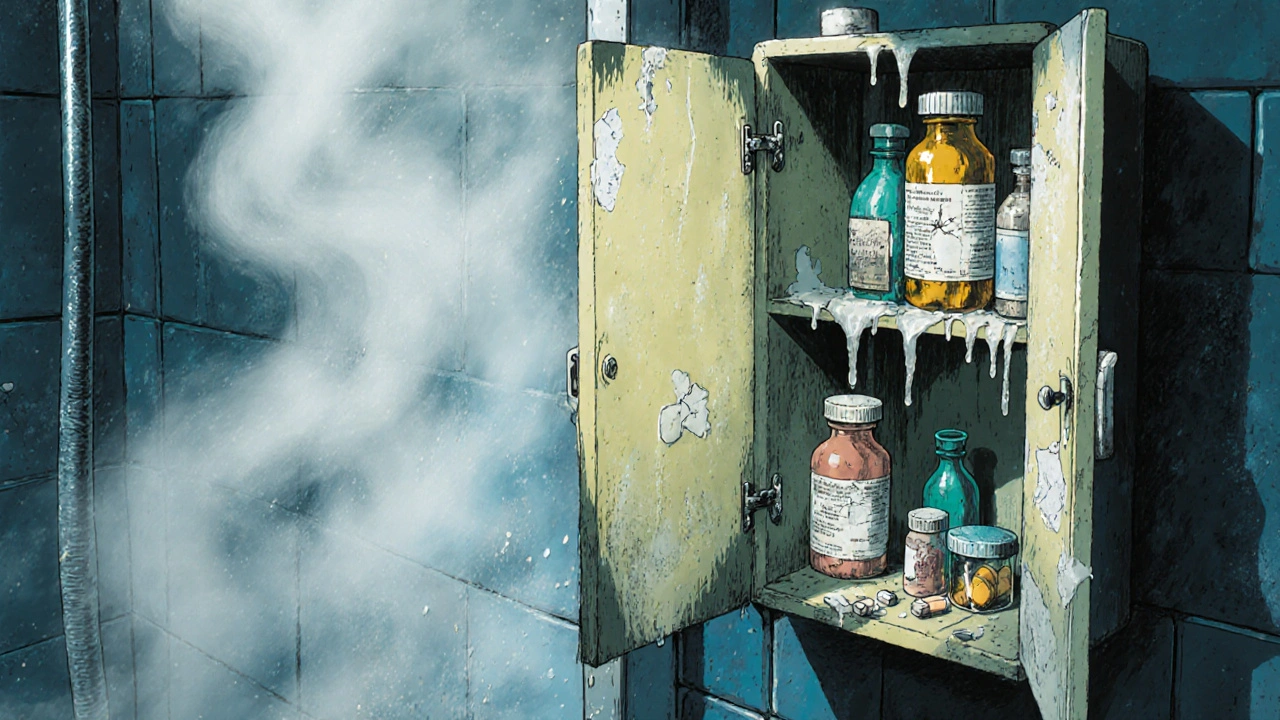Why Your Medications Expire Sooner Than They Should
You bought that prescription painkiller or antibiotic with a two-year expiration date, but it’s already useless after just eight months. Why? It’s not magic. It’s not bad luck. It’s probably because you stored it in the bathroom.
The FDA says medications are guaranteed to work up to their printed expiration date - only if they’re stored correctly. But 37% of premature expirations in U.S. homes happen because of poor storage, according to the CDC. And the biggest culprit? Humidity.
That medicine cabinet above your sink? It’s a steam room. Every shower pushes humidity to 85-95%. Aspirin breaks down 300% faster in that environment. Liquid antibiotics, insulin, and even your daily multivitamin can lose potency in weeks if left in the wrong spot.
Where NOT to Store Your Medications
- Bathroom medicine cabinets - High heat and moisture from showers ruin tablets, capsules, and liquids. Even if the bottle says "room temperature," it doesn’t mean "steam room temperature."
- Kitchen counters near the stove or oven - Temperature swings of 15°C or more in under 30 minutes degrade 42% of common antibiotics within 90 days, per Swedish Medical Center research.
- Car glove compartments - Summer heat can hit 70°C (160°F). Pills melt. Liquids separate. Insulin becomes useless.
- Direct sunlight - UV light breaks down nitroglycerin, thyroid meds, and some antidepressants. Clear bottles offer almost zero protection.
- Dresser drawers with no climate control - While better than the bathroom, drawers in hot or drafty rooms still expose meds to fluctuating temps.
Where to Store Medications for Maximum Shelf Life
The sweet spot for most pills and capsules is 20-25°C (68-77°F) with humidity below 60%. That’s not your bathroom. It’s not your kitchen. It’s a cool, dry drawer or cabinet in a bedroom or living room - away from windows and vents.
Use a simple digital hygrometer (under $10 online) to check humidity. If it’s above 60%, move your meds. You don’t need a climate-controlled room - just a stable one.
Keep everything in its original container. The amber glass bottles used for prescriptions block 97% of UV light. Transfer pills to pill organizers? Fine - but only for daily doses. Keep the bulk supply sealed and labeled.
Special Cases: Insulin, Nitroglycerin, and Other Sensitive Drugs
Not all meds are created equal. Some need extra care.
- Insulin - Unopened? Refrigerate at 2-8°C (36-46°F). Opened? Can stay at room temperature (up to 25°C) for up to 28 days. Never freeze it. Never leave it in a hot car.
- Nitroglycerin tablets - Must stay in the original dark glass bottle. Exposure to light or air cuts potency by 50% in days. Replace every 3-6 months even if the bottle says otherwise.
- Eye drops - Once opened, most expire in 28 days. The American Society of Health-System Pharmacists found 78% of expired eye drops grow dangerous bacteria like Pseudomonas aeruginosa.
- Reconstituted antibiotics - Liquid forms like amoxicillin suspension last only 14 days in the fridge. Write the discard date on the bottle when you first open it.

How to Know If Your Medication Has Gone Bad
Expiration dates aren’t magic. But signs of degradation are obvious if you know what to look for.
- Smell - Aspirin that smells like vinegar? It’s broken down into acetic acid. Don’t take it.
- Color - Tablets or capsules that are darker, lighter, or have spots? Toss them. A 15% color change is a red flag.
- Texture - Crumbly pills, sticky capsules, or cloudy liquids? That’s not normal. It means moisture or heat damaged the formula.
- Particles - If you see floating bits in liquid meds, even tiny ones, throw it out. Contamination risk is real.
If you’re unsure, don’t guess. Call your pharmacist. They’ll tell you in seconds whether it’s safe.
Organize and Track Expirations Like a Pro
Most people forget when their meds expire until they’re already bad. A simple system cuts that risk by 89%, according to Kaiser Permanente.
- Set a monthly reminder on your phone: "Check meds."
- Take everything out of the storage box.
- Check expiration dates. Write the date you opened liquids on the bottle.
- Use colored dot stickers: red = this year, blue = next year, green = two years out. (This method reduced expired meds by 63% in a University of Wisconsin trial.)
- Put anything expired or questionable in a separate bag to dispose of safely.
Assign one person in the household to handle this. It takes 10 minutes a month. That’s less time than scrolling through social media.
Smart Tools That Actually Help
Technology can make this easier.
- Smart pillboxes like the MedMinder Pro track temperature and humidity inside the box and send alerts if conditions go outside safe ranges.
- Silica gel packets - You’ve seen them in shoeboxes and snack packs. Some new prescription bottles now include them. They keep humidity inside the bottle down by 45%.
- Newer insulin formulations - Merck’s heat-stable insulin (approved Dec 2023) stays potent at 30°C for 56 days. That’s a game-changer for people without reliable refrigeration.
These aren’t gimmicks. They’re tools backed by real data. If you’re managing multiple chronic conditions, they’re worth the investment.

How to Dispose of Expired or Unwanted Medications
Never flush pills. Never throw them in the trash without mixing them with coffee grounds or cat litter. Both methods risk contamination and accidental ingestion.
The safest way? Use a DEA National Prescription Drug Take Back Day event. There are over 11,000 drop-off sites across the U.S. You can find the nearest one at deas.gov/takebackday. (Next event: October 26, 2024.)
If you can’t wait, mix expired pills with an unappetizing substance like dirt, coffee grounds, or cat litter. Seal it in a plastic bag. Throw it in the trash. Write "Do Not Consume" on the bag.
What’s Changing in Medication Storage
The FDA is pushing for better solutions. By 2025, they may require real-time stability indicators on high-risk meds - think color-changing labels that show when a pill is degrading.
Pharmacies are also updating labels. 78% of new prescriptions now include storage icons: a snowflake for refrigerated, a sun with a slash for light-sensitive, a house with a thermometer for room temp.
And community programs like the American Pharmacists Association’s "Store It Safe" campaign have already educated 1.2 million households. In those areas, premature expiration dropped by 27%.
Why This Matters More Than You Think
Every year, Americans waste $20 billion on expired medications. That’s money spent on pills that don’t work. That’s risk to your health if you take degraded drugs. That’s environmental harm from flushing or landfilling.
But it’s not just about money. If your blood pressure med loses potency, you could have a stroke. If your antibiotic fails, an infection could turn deadly. Proper storage isn’t a chore - it’s part of your treatment plan.
Storing meds right doesn’t require a fancy cabinet or a degree in chemistry. It just requires knowing where not to put them - and making a small habit to check them once a month.

13 Comments
Iska Ede November 18 2025
So let me get this straight-I’ve been storing my insulin in the bathroom because I thought "room temperature" meant "steam room temperature"? 😅 Thanks for the slap in the face with a wet towel of reality.
Katelyn Sykes November 19 2025
I never thought about humidity being the real enemy until now. I had a bottle of amoxicillin that turned weirdly sticky last winter and just tossed it. Turns out I was right to be suspicious. Also the colored dot system? Genius. I’m stealing that.
Gabe Solack November 20 2025
Smart pillboxes are a game changer if you’re on 5+ meds. Mine alerts me if it’s too hot or if I miss a dose. Also silica gel packets? I started putting them in my vitamin jar and it’s been 6 months and zero moisture issues. 🙌
Gabriella Jayne Bosticco November 21 2025
I used to keep everything in the bathroom until my mom told me she’d seen pills dissolve in the humidity. She’s 72 and still runs a tighter ship than most pharmacists. Now my meds live in a locked drawer in the bedroom. Simple. Safe. No drama.
Denny Sucipto November 23 2025
I used to think expiration dates were just corporate lies to make us buy more. But after my grandpa took old blood pressure pills and ended up in the ER? Yeah. No more guessing. I check mine every month like clockwork. Even if it’s just 10 minutes. It’s not a chore-it’s a lifeline.
Bailey Sheppard November 24 2025
This is the kind of post that makes you feel seen. I’ve been storing my thyroid med in the kitchen because I forgot where else to put it. Now I know. Thanks for making this feel doable instead of overwhelming. Small changes really do add up.
Hal Nicholas November 25 2025
I can’t believe people still don’t know this. I mean, really? You’re telling me you didn’t learn this in high school health class? The FDA has been screaming about this for decades. And now we’re paying for it with our health and our wallets. Pathetic.
Kristina Williams November 27 2025
I heard the FDA is secretly adding tracking chips to all pills now. That’s why they changed the labels. They’re watching us. And the heat-stable insulin? That’s not progress-that’s a trap. They want us dependent on corporate tech. Don’t fall for it.
Yash Nair November 28 2025
USA still the best? I mean in India we just keep all meds in the kitchen under the sink. Who cares if its hot? We dont have fancy pillboxes. We just take it and pray. You Americans overthink everything.
Shaun Barratt November 29 2025
The degradation rate of aspirin under high humidity conditions has been empirically documented since the 1980s. The 300% increase in hydrolysis is well cited in the Journal of Pharmaceutical Sciences. Furthermore, the amber glass packaging used in prescription containers attenuates UV radiation with an absorption coefficient of 0.97, as verified by spectrophotometric analysis. Storage in stable, low-humidity environments remains the gold standard.
Christine Eslinger November 30 2025
It’s funny how something so simple-knowing where to put a pill-can be the difference between healing and harm. We treat our phones like sacred objects, but we toss our medicine in the steamiest room in the house. Maybe we need to start treating our bodies with the same care we give our gadgets.
Kristi Joy December 1 2025
I started using the colored dot system after my mom had a bad reaction to expired antibiotics. Now my whole family does it. We even have a little chart on the fridge. It’s not perfect, but it’s made us way more aware. And honestly? It’s kind of nice to have a little ritual that keeps us all connected.
Louie Amour December 3 2025
You think this is revolutionary? I’ve been using silica gel packets since 2018. I even bought a humidity-controlled safe for my insulin. Meanwhile, most people still think "cool and dry" means the back of the fridge. You’re five years behind. And the FDA’s new labels? Barely a step forward. Real innovation? That’s what we need.